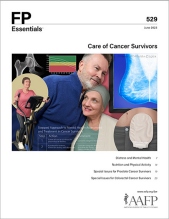
This clinical content conforms to AAFP criteria for CME.
In the United States, prostate cancer is the most common nonskin cancer in men. Approximately 12.6% of US men will be diagnosed with this cancer in their lifetimes. Although the overall 5-year relative survival rate is high (96.8%), ethnic and racial disparities have been shown to affect survival. There also are genetic risks. If the family history of the patient includes familial cancers, the patient and family members should be referred for genetic counseling and testing for cancer-associated sequence variants. Prostate cancer treatments have significant long-term effects. After radical prostatectomy, 27% to 29% of patients experience urinary incontinence and 66% to 70% have erectile dysfunction. These effects also can occur after radiation therapy, though at lower rates. Mild urinary incontinence can be managed with incontinence pads. The most effective treatments are artificial urinary sphincter implantation and urethral sling procedure. Urinary incontinence after radiation therapy tends to decrease over time. Symptoms of urinary urgency or nocturia can be managed with anticholinergic drugs. Erectile dysfunction typically is managed with oral phosphodiesterase type 5 inhibitors and/or vacuum pump erectile devices. Androgen deprivation therapy increases cardiovascular risk by increasing insulin resistance and blood pressure. This therapy also is associated with osteoporosis, so patients with nonmetastatic cancer and one or more risk factors for fracture should be offered fracture risk assessment and bone mineral density testing.
Subscribe
From $350- Immediate, unlimited access to FP Essentials content
- 60 CME credits/year
- AAFP app access
- Print delivery available
Edition Access
$44- Immediate, unlimited access to this edition's content
- 5 CME credits
- AAFP app access
- Print delivery available
